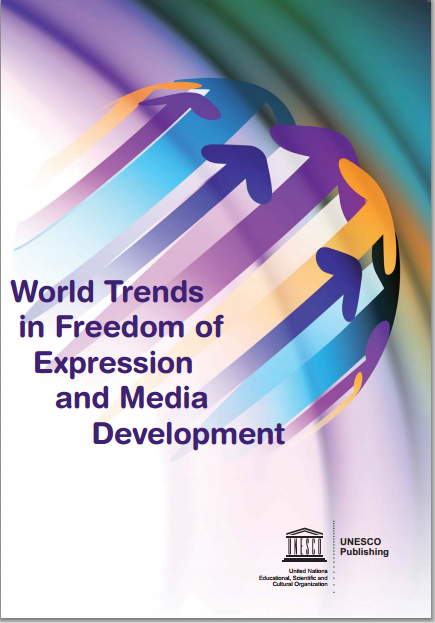Unesco lança a publicação World Trends in Freedom Of Expression and Media Development
Unesco lança a publicação World Trends in Freedom Of Expression and Media Development.
Executive Sumary:
Freedom of expression in general, and media development in particular, are core to UNESCO’s constitutional mandate to advance ‘the mutual knowledge and understanding of peoples, through all means of mass communication’ and promoting ‘the free flow of ideas by word and image.’ For UNESCO, press freedom is a corollary of the general right to freedom of expression. Since 1991, the year of the seminal Windhoek Declaration, which was endorsed by our Member States, UNESCO has understood press freedom as designating the conditions of media freedom, pluralism and independence, as well as the safety of journalists. It is within this framework that this report examines progress as regards press freedom, including in regard to gender equality, and makes sense of the
evolution of media actors, news media institutions and journalistic roles over time.
This report has been prepared as the basis of a summary report on the global state of press freedom and the safety of journalists, presented to the General Conference of UNESCO Member States in November 2013, on the mandate of the decision by Member States taken at the 36th session of the General Conference of the Organization.
The overarching global trend with respect to media freedom, pluralism, independence
and the safety of journalists over the past several years is that of disruption and change
brought on by technology, and to a lesser extent, the global financial crisis. These trends
have impacted traditional economic and organizational structures in the news media, legal and regulatory frameworks, journalism practices, and media consumption and production habits. Technological convergence has expanded the number of and access to media platforms as well as the potential for expression. It has enabled the emergence of citizen journalism and spaces for independent media, while at the same time fundamentally reconfiguring journalistic practices and the business of news.
The broad global patterns identified in this report are accompanied by extensive
unevenness within the whole. The trends summarized above, therefore, go hand in hand
with substantial variations between and within regions as well as countries.
Para acessar o documento: http://unesdoc.unesco.org/images/0022/002270/227025e.pdf
Executive Sumary:
Freedom of expression in general, and media development in particular, are core to UNESCO’s constitutional mandate to advance ‘the mutual knowledge and understanding of peoples, through all means of mass communication’ and promoting ‘the free flow of ideas by word and image.’ For UNESCO, press freedom is a corollary of the general right to freedom of expression. Since 1991, the year of the seminal Windhoek Declaration, which was endorsed by our Member States, UNESCO has understood press freedom as designating the conditions of media freedom, pluralism and independence, as well as the safety of journalists. It is within this framework that this report examines progress as regards press freedom, including in regard to gender equality, and makes sense of the
evolution of media actors, news media institutions and journalistic roles over time.
This report has been prepared as the basis of a summary report on the global state of press freedom and the safety of journalists, presented to the General Conference of UNESCO Member States in November 2013, on the mandate of the decision by Member States taken at the 36th session of the General Conference of the Organization.
The overarching global trend with respect to media freedom, pluralism, independence
and the safety of journalists over the past several years is that of disruption and change
brought on by technology, and to a lesser extent, the global financial crisis. These trends
have impacted traditional economic and organizational structures in the news media, legal and regulatory frameworks, journalism practices, and media consumption and production habits. Technological convergence has expanded the number of and access to media platforms as well as the potential for expression. It has enabled the emergence of citizen journalism and spaces for independent media, while at the same time fundamentally reconfiguring journalistic practices and the business of news.
The broad global patterns identified in this report are accompanied by extensive
unevenness within the whole. The trends summarized above, therefore, go hand in hand
with substantial variations between and within regions as well as countries.
Para acessar o documento: http://unesdoc.unesco.org/images/0022/002270/227025e.pdf




Comentários
Postar um comentário